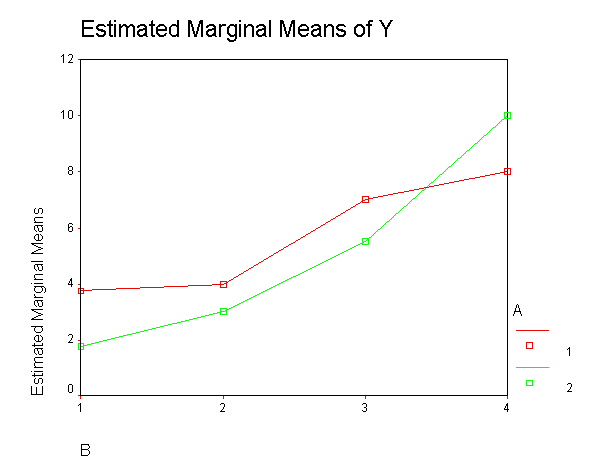Let’s read in an example dataset, crf24, adapted from Kirk (1968, First Edition).
get file 'c:https://stats.idre.ucla.edu/wp-content/uploads/2016/02/crf24.sav'.
These data are from a 2×4 factorial design. The variable y is the dependent variable. The variable a is an independent variable with two levels, while b is an independent variable with four levels. Let’s look at a table of cell means and standard deviations.
means table = y by a by b.
Case Processing Summary Cases Included Excluded Total N Percent N Percent N Percent Y * A * B 32 100.0% 0 .0% 32 100.0%
Report
YA B Mean N Std. Deviation 1 1 3.75 4 1.500 2 4.00 4 .816 3 7.00 4 .816 4 8.00 4 .816 Total 5.69 16 2.120 2 1 1.75 4 .500 2 3.00 4 .816 3 5.50 4 .577 4 10.00 4 .816 Total 5.06 16 3.316 Total 1 2.75 8 1.488 2 3.50 8 .926 3 6.25 8 1.035 4 9.00 8 1.309 Total 5.38 32 2.756
Now let’s run the ANOVA.
glm y by a b.
Between-Subjects Factors N A 1 16 2 16 B 1 8 2 8 3 8 4 8
Tests of Between-Subjects Effects
Dependent Variable: YSource Type III Sum of Squares df Mean Square F Sig. Corrected Model 217.000(a) 7 31.000 40.216 .000 Intercept 924.500 1 924.500 1199.351 .000 A 3.125 1 3.125 4.054 .055 B 194.500 3 64.833 84.108 .000 A * B 19.375 3 6.458 8.378 .001 Error 18.500 24 .771 Total 1160.000 32 Corrected Total 235.500 31 a R Squared = .921 (Adjusted R Squared = .899)
We see that in addition to a significant main effect for b there is a significant a*b interaction effect. Before we do any of the tests of simple main effects, let’s graph the cell means to get an idea of what the interaction looks like. You can include a /plot subcommand with the glm command to get a plot of the cell means.
glm y by a b /plot = profile(b*a).<output omitted>

The interaction is clearly shown where the two lines cross over between levels b3 and b4. We will now do a test of simple main effects looking at differences in a at each level of b. This is done by including a /emmeans subcommand with the glm command.
glm y by a b /emmeans = tables(a*b)compare(a).
Between-Subjects Factors N A 1 16 2 16 B 1 8 2 8 3 8 4 8
Tests of Between-Subjects Effects
Dependent Variable: YSource Type III Sum of Squares df Mean Square F Sig. Corrected Model 217.000(a) 7 31.000 40.216 .000 Intercept 924.500 1 924.500 1199.351 .000 A 3.125 1 3.125 4.054 .055 B 194.500 3 64.833 84.108 .000 A * B 19.375 3 6.458 8.378 .001 Error 18.500 24 .771 Total 1160.000 32 Corrected Total 235.500 31 a R Squared = .921 (Adjusted R Squared = .899)
Estimates
Dependent Variable: YMean Std. Error 95% Confidence Interval A B
Lower Bound Upper Bound 1 1 3.750 .439 2.844 4.656 2 4.000 .439 3.094 4.906 3 7.000 .439 6.094 7.906 4 8.000 .439 7.094 8.906 2 1 1.750 .439 .844 2.656 2 3.000 .439 2.094 3.906 3 5.500 .439 4.594 6.406 4 10.000 .439 9.094 10.906
Pairwise Comparisons
Dependent Variable: YMean Difference (I-J) Std. Error Sig.(a) 95% Confidence Interval for Difference(a) B (I) A (J) A
Lower Bound Upper Bound 1 1 2 2.000(*) .621 .004 .719 3.281 2 1 -2.000(*) .621 .004 -3.281 -.719 2 1 2 1.000 .621 .120 -.281 2.281 2 1 -1.000 .621 .120 -2.281 .281 3 1 2 1.500(*) .621 .024 .219 2.781 2 1 -1.500(*) .621 .024 -2.781 -.219 4 1 2 -2.000(*) .621 .004 -3.281 -.719 2 1 2.000(*) .621 .004 .719 3.281 Based on estimated marginal means * The mean difference is significant at the .050 level. a Adjustment for multiple comparisons: Least Significant Difference (equivalent to no adjustments).
Univariate Tests
Dependent Variable: YB Sum of Squares df Mean Square F Sig. 1 Contrast 8.000 1 8.000 10.378 .004 Error 18.500 24 .771 2 Contrast 2.000 1 2.000 2.595 .120 Error 18.500 24 .771 3 Contrast 4.500 1 4.500 5.838 .024 Error 18.500 24 .771 4 Contrast 8.000 1 8.000 10.378 .004 Error 18.500 24 .771 Each F tests the simple effects of A within each level combination of the other effects shown. These tests are based on the linearly independent pairwise comparisons among the estimated marginal means.
Note: Statisticians do not universally approve of the use of tests of simple main effects. In particular, there are concerns over the conceptual error rate. Tests of simple main effects are one tool that can be useful in interpreting interactions. Caution should be exercised in interpreting the results of analyses of simple main effects. In general, the results of tests of simple main effects should be considered suggestive and not definitive.
You can get more information on this topic by visiting:
